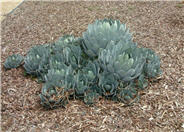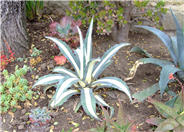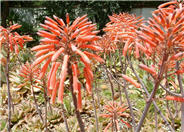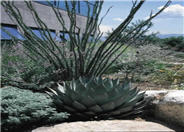
Common name:Huachuca Agave
Botanical name:Agave parryi v. huachucensis
This Agave grows slowly to 2' by 2'. It is lump forming with dense rosettes. It has short gray leaves with dark thorns on the margins. This is the largest of the subspecies of parryi with leaves 2' long. It is native to parts of AZ and is more robust, with larger leaves and broader panicles and larger flowers than the species. It is primarily found in oak and pine woodlands.

Common name:Medio Picta Century Plant
Botanical name:Agave americana medio-picta
This form has arching leaves with a creamy white stripe down the center of the blue-green leaf. The leaves are outstanding with their arching form and are well armed with a stout, terminal spine as well as marginal teeth. It is somewhat smaller than the americana variety, growing to around 4.' It prefers full sun, well drained soil and will perform well in containers. This form also will die after bloom but will survive in the form of new pups around the old plant. Susceptible to Agave Snout Weevil.

Common name:Shrimp Pink Aloe
Botanical name:Aloe maculata
This succulent plant will grow about 2' high and has large, greenish/white leaves with orange, pink, and red flowers that bloom in spring and fall.

Common name:Parrasana Agave
Botanical name:Agave parrasana
This Agave is native to Coahuila, Mexico from 4500'-8000' elevation and is similar in appearance to Agave parryi. Solitary plant forms tight rosette 2' by 2' resembling a cabbage. It has stout gray leaves edged with small teeth and a sharp terminal spine. This plant needs full sun to part shade. It will offset to form a dense colony.
| Designer: | Sonoran Look |
Photographer: GardenSoft |
Soils and Compost:
Physical weed control, including mulching, or hand removal protects the watershed from harmful chemicals.
Water Saving Tip:
Lawn watering more than 5 minutes usually results in runoff. Use multiple cycle starts.
Integrated Pest Management:
Drip and other smart irrigation delivers water directly to roots, allowing no excess water for weeds.

